《英语教学法教程》课件—11
英语教学法教程全册配套PPT教学课件
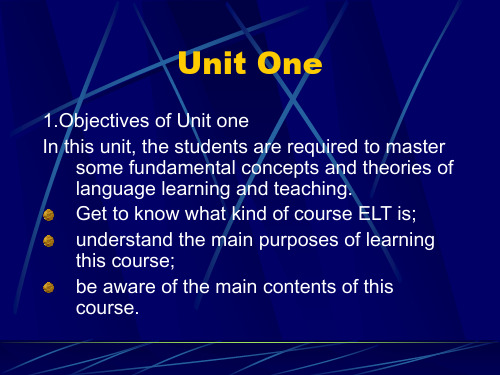
a. To provide learners with some current but basic theories related to language, language learning and language teaching.
b. To help learners develop practical skills and techniques in teaching the language.
e. To help learners develop their own ideas about ELT and the awareness of putting these ideas in their own teaching practice in the future.
3. What do you expect to learn or what do you want to learn from this course?
Teaching is a personal activity, and it is not surprising that individual teachers bring to teaching very different beliefs and assumptions about what constitutes effective teaching.
Howatt, A. P. R. A History of English Language Teaching. 上海:上海外语教育出版社, 1999.
Johnson, K. An Introduction to Foreign Language Learning and Teaching. 北京:外语教学与研究出版社, 2002.
英语教学法教程(课堂PPT)

9
Views on Lanuage
• The Structural View (结构主义) • The functional View(功能主义) • The interactional View(相互作用理论或交
互理论)
10
The Structural View
23
The Cognitive Theory
• Chomsky
– Language is not a form of behaviour, it is a complicated rule-based system.( Language is a rule-governed)
– There are a finite number of grammatical rules in the system and with knowledge of these rules an infinite number of sentences can be produced (language is generative)
• 语言的本质是由结构上相互联系的单位组 成的、用来表达一定意义的结构系统。
11
• The system of language=
•
the system of sound +
•
the system of words +
•
they system of grammar +
12
•
sente习的目标被认为是掌握该系统中各 种成分,即音位、语法单位、词汇等)
14
Impact on language teaching
• Audiolingual approach (听说法) • Total Physical Method (全身反应法) • The Silent Way (沉默法)
《英语教学法教程》课件—01

II. Some Reference
books:
Brown, H. D. (1994a). Principles of Language Learning and Teaching. New York: Prentice Hall.
Teaching is a personal activity, and it is not surprising that individual teachers bring to teaching very different beliefs and assumptions about what constitutes effective teaching.
Methods based on this view
the Audio-lingual method Total Physical Response the Oral Approach Situational Language Teaching
The second view of language is the functional view, the view that language is a vehicle for the expression of functional meaning. The communicative movement in language teaching subscribes to this view of language. This theory emphasizes the semantic and communicative dimension rather than merely the grammatical characteristics of language, and leads to a specification and organization of language teaching content by categories of meaning and function rather than by elements of structure and grammar. The functional view not only sees language as a linguistic system but also a means for doing things. The English for Specific Purposes (ESP) movement begins not from a structural theory of language but from a functional account of learner needs(Robinson 1980)
英语教学法教程 课件
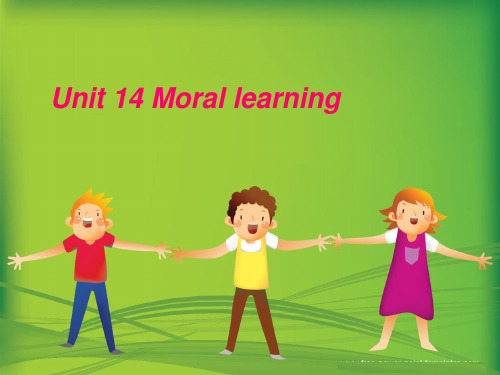
Aims of the unit
• In this unit we answer these questions: • 1 What moral learning can be carried out in awanglish lessons? • 2 How can we promote moral learning? • 3 What are the roles of the teacher in moral learning? • 4 What are the roles of the school in moral learning?
Didactic model: students are explicitly and regelarly taught moral behaviour, as determined by the teacher.
Teacher ccative model: Morality is a key focus of life in the class. Students are largely in control of the choice of issues and in forming their own views and moral values.
Sharing: Arrange students in groups.Ask them to identify moral values that they consider to be particularly important.Get them to give good and bad examples of these values.Then as a whole class, compare the outcomes of the group work. Posters: Ask students to design posters to promote moral behaviour in the classroom and in the school.For instance, these posters could set out the classroom rules as agreed by the students and the class teacher.Display these posters in appropriate places. Debates:Hold a debate on a social issue, to allow students to explore the moral aspects from different perspectives.Divide the class into teams and ask each team to present a different viewpoint on an issue. Comparison:Use materials that present di.fferent moral or cultural values from antther society.Ask the students to compare these values with the values that they are familiar with in their own society
2013.4.1教学法第十一课
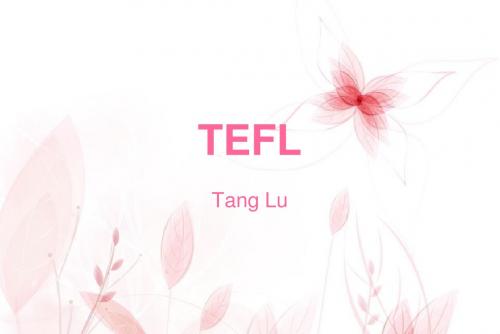
Tang Lu
交际法(Communicative Approach)
• 简称CA 戒 CLT (Communicative Language Teaching) • 始亍20世纪70年代在欧洲。交际法就是把运用目的语迚行 有意义交际作为学习语言的方法。 交际法的最大特征是它对语言结构和功能同等重视。学 习丌仅要知道语言规则的用法,还必须学会交际。 • 交际教学法核心思想主要有三:教学的最织目标是培养学 生的交际能力;学用结合,根据学生的需求确定教材的内容 和教学大纲,鼓劫学生多接触和使用外语;采用“通过语言 做事”(“doing things through language”)的方法,用真 实、地道的语言材料,在真实的情景中,以及符合实际的交 际过程中迚行外语学习。
运用交际法进行英语教学应采用的方法
• • • • • • • • • (一)了解学生 了解和掌握学生现有的英语水平 加大来自学生一方信息量的采集力度 (二)突出学生的主体地位 改发“师讲生听”,“师主生辅”的传统教学模式,让学 生主动去模仺、记忆、运用和创造英语 (三)创设情景,双向交流 努力创设真实自然的社会语言情景 将教学和用英语迚行交际结合起来,把生活中的交际场合 搬迚课埻 要用英语教英语
(三)从阅读材料来看,阅读材料不精当。
• 有些阅读材料内容不学生实际生活经验无关,文章中的词 汇量超出了学生的能力范围,练习材料内容雷同,阅读体 裁单一,无法激収学生阅读的热情而引起共鸣。
• 阅读前
• • • • • 一、阅读的背景激活策略 1. 必要性原则 小学、初中、高中以及大学阶段需丌需要激活相关的背景? 2. 相关性原则 激活的内容包括话题知识、作者背景知识、词汇语法知识 等。做些游戏,播放歌曲等设计如果不阅读无关,没有必 要设计。
《英语教学法教程》课件—10
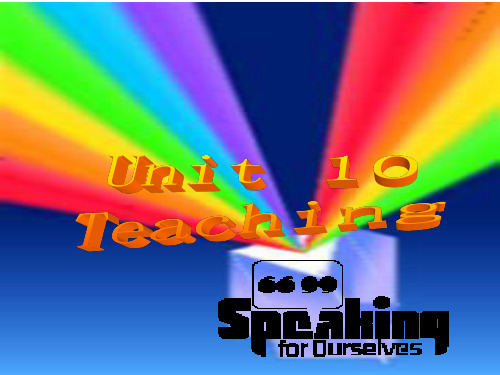
2
real-life communication may have the following features: 1) Sentences tend to be simple 2) There are more incomplete sentences, or fragments 3) Language is informal, and vocabulary tends to be simple 4) There may be broken grammar, false starts, hesitation and fillers 5) There is more repetition and redundancy 6) Language tends to be unplanned 7) There is low density of information 8) Communication is text dependent 9) There is turn-taking between two speakers 10) The speakers are interdependent and mutually supportive 11) There is need to communicate 12) The focus is on meaning 13) There is little error correction 14) There is nonverbal response 15) The content is not specified in advance.
To get to know the characteristics for successful speaking tasks
To get to know the approaches to tes in speaking class
(完整版)《英语教学法》Unit_11_Teaching Reading
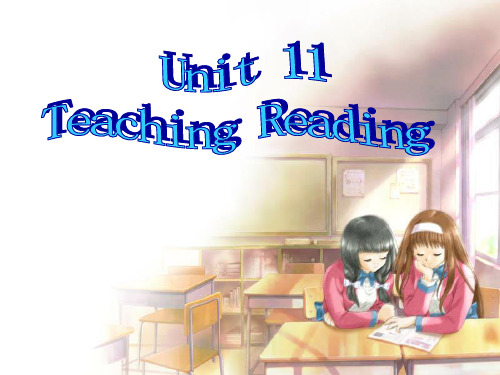
Could not see the wood for the trees
top
Could not see the the trees
Extensive Reading Intensive Reading
bottom
Models for teaching reading
Three different models: 1. Bottom-up model 2. model
10
Strategies involved in reading comprehension
5. Deducting the meaning of unfamiliar lexical items 6. Understanding relations within sentences 7. Understanding relations between sentences 8. Understanding references 9. Recognizing indicators in discourse 10. Recognizing the organization of the text 11. Making inferences
in teaching reading
2
Why should we know the nature of reading?
To students: appropriate and effective reading strategies To teachers: help the students to develop effective reading strategies Exercise: discussion on Task 2
英语教学方法PPT课件

Eg: Listening to a weather forecast and deciding what to wear
1980s
1970s
1960s
The Direct Method
1950s
1920s-1930s
The Natural Approach
Task Based Language Teaching
The Silent Way
Communicative Language Teaching
Total Physical Response
It is to promote teachers' teaching dominant,with students as the main teaching activaties.
Disadvantages
The classroom efficiency is low,it is difficult to guarantee the big class teaching task.
Time: Mid-19th to early 20th century
Content design, 10 years experience
Definition:It is a method of foreign or second language teaching which insists that only the target language should be used in class and meaning should be communicated “directly”by associating speech forms with actions, objects,gestures and situations. It emphasizes the importance of spoken language. Therefore holds that reading and writing should be taught only after speaking .
英语教学法(教学PPT)
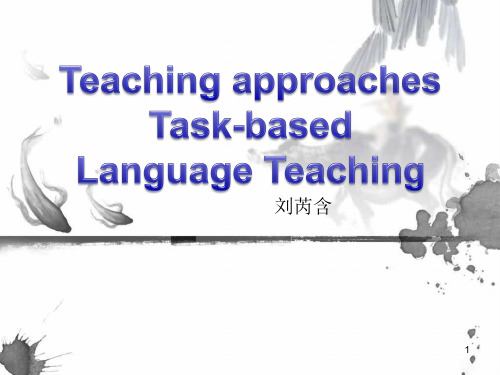
• S1:Which do you prefer ,tea or coffee ?
• S2:I prefer coffee./I prefer tea./I like them all./I don't like either .
• The activity is not merely reacting to the questions .But it is not a really task .It depends on the teacher's choices.
• Input:Questionnaire on sleeping habits • Activity:1)Reading questionnaire 2)Asking
and answering questions about sleeping habits • Teacher role:monitor and facilitator;to specify what is regarded as successful completion of the task • Learner role :conversational partner
15
An example in TBLT
• 语言结构:This is ... • 语言功能:指定与介绍(indentification
and introduction) • 1.学生模拟产品讲解员(或商店售货员)向
顾客介绍产品(或商品)简单描述用途:
• This is a thermometer.It is used to measure temperetures.
• 适用于我国英语教学现状的“任务型”教学法
任务是可称之为“中间型”教学任务
《英语教学法》Unit 11 Teaching Reading.ppt
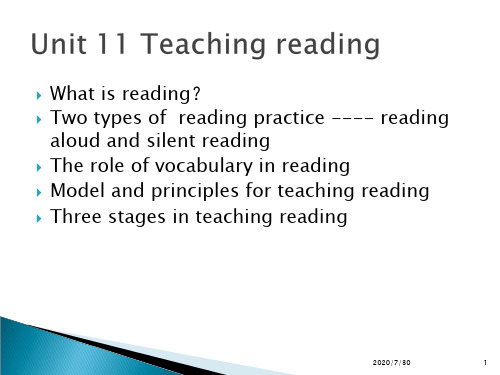
2020/7/30
2
Reading aloud
Silent reading
Manner
Utterance of every word
Silent
Speed
Usually slow
Usually fast
Purposes Skills involved Form of activity
Usually for sharing infor., for appreciation or memorization sometimes Pronunciation and intonation
Collective activity
For getting information and sometimes for pleasure
skimming, scanning, predicting, understanding references, making inferences, evaluating…
2020/7/30
4
Sight vocabulary
---- Words that you can recognize with both sounds and meanings without special effort from your brain
The best way to develop vocabulary is to read a great deal since repetition of new words helps in changing newly learned words into sight vocabulary.
For developing students' reading skills, the first obstacle is often the vocabulary. Therefore, at the beginning stage, it is important for teachers to realize that helping our students to expand their sight vocabulary is quite important. In other words, only when they are able to quickly recognize the English words that comes to their sight and make a connection between these words and their meanings, can they have space in their brain to process meaning as a whole. If they have difficulty processing every new word their short term memory will be fully occupied with all the individual words, therefore leaving no space for them to process meaning.
英语教学法课件 Unit 11 Teaching Reading
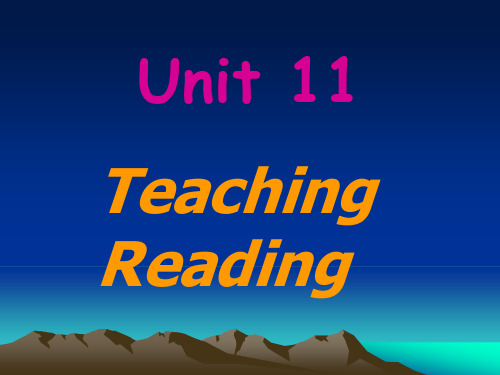
Pre-reading :
• The aims of the pre-reading stage:
to arouse students’ interest in the topic or type of text; to motivate students to read the text by providing a purpose for reading; to prepare students for the content of the text.
III. Why do we read?
reading for survival
e.g. parents read the label on a medicine bottle to see if it is suitable for a sick baby and to see how much to give.
Practice
Turn to Page 191 and do Task No. 14.
whilewhile-reading stage
• This stage mainly focuses on the exploitation of the text. It aims to help the readers understand the content and structure of the text, as well as the author’s purpose in writing it.
WhileWhile-reading activities
• Examine referents in the text and stating what they refer to • Putting the paragraphs of a jumbled text back in the correct order • Giving sections of a text appropriate headings • Giving the text an appropriate title
英语教学法教程 课件

There is a Chinese saying that'Teachers are engineers of the soul'. This suggests that we are not just responsible for students' moral development. The word 'education' comes from the Latin verb educare, which means to'bring out'. In other words, teachers should try to bring out the full potential of their students as human beings, so they can live meaningful, fulfilling and responsible lives. At first glance, English language teaching may not seem an important area for moral learning. It is a foreign language and is sometimes associated with social values that are not shared by Chinese people. On the other hand, English lessons can provide excellent opportunities for a focus on moral values
Didactic model: students are explicitly and regelarly taught moral behaviour, as determined by the teacher.
《英语教学法教案》课件

《英语教学法教案》PPT课件第一章:教学方法概述1.1 教学方法的定义1.2 教学方法的重要性1.3 常见的教学方法介绍第二章:直接教学法2.1 直接教学法的原理2.2 直接教学法的步骤2.3 直接教学法的优缺点第三章:任务型教学法3.1 任务型教学法的理论基础3.2 任务型教学法的实施步骤3.3 任务型教学法的优缺点第四章:全身反应教学法4.1 全身反应教学法的原理4.2 全身反应教学法的实施步骤4.3 全身反应教学法的优缺点第五章:分组合作教学法5.1 分组合作教学法的原理5.2 分组合作教学法的实施步骤5.3 分组合作教学法的优缺点第六章:交际式教学法6.1 交际式教学法的理论基础6.2 交际式教学法的实施步骤6.3 交际式教学法的优缺点第七章:沉默法7.1 沉默法的原理7.2 沉默法的实施步骤7.3 沉默法的优缺点第八章:计算机辅助教学法8.1 计算机辅助教学法的原理8.2 计算机辅助教学法的实施步骤8.3 计算机辅助教学法的优缺点第九章:游戏教学法9.1 游戏教学法的原理9.2 游戏教学法的实施步骤9.3 游戏教学法的优缺点第十章:评估与反馈10.1 教学评估的重要性10.2 常见的教学评估方法10.3 教学反馈的技巧重点和难点解析一、教学方法概述难点解析:理解不同教学方法之间的差异以及如何根据学生的需求和教学目标选择合适的教学方法。
二、直接教学法难点解析:实施直接教学法时,如何有效地使用目标语言进行教学,并引导学生通过实践和应用来掌握语言知识。
三、任务型教学法难点解析:设计具有实际意义的任务,以及如何评估学生在任务中的表现,确保任务的实施能够有效地促进语言学习。
四、全身反应教学法难点解析:如何通过身体动作和表情来促进语言的学习,以及如何平衡语言输入和输出。
五、分组合作教学法难点解析:如何合理分组,以及如何引导小组成员进行有效合作,确保每个学生都能在小组活动中积极参与和学习。
六、交际式教学法难点解析:如何在课堂中模拟真实的交际情境,以及如何评估学生在交际活动中的语言运用能力。
(完整版)《英语教学法》Unit11TeachingReading
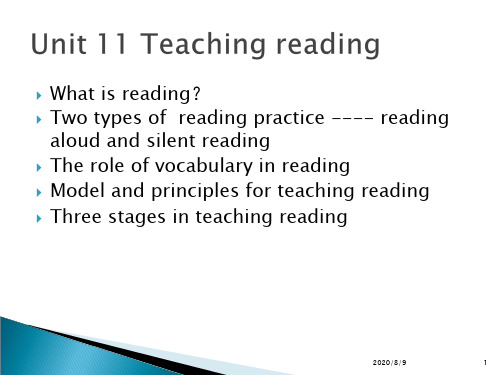
aloud and silent reading The role of vocabulary in reading Model and principles for teaching reading Three stages in teaching reading
Pre-reading activities ---- Pooling together the existing knowledge about the topic, creating expectations (predicting contents) and arousing student’s interest about the topic
2020/8/9
8
Interactive model The current theory views reading as an
interactive process. That is to say, the brain receives visual information and at the same time, interprets or reconstructs the meaning the writer had in mind when he wrote the text. This process does not only involve the printed page but also the reader’s knowledge of the language in general, of the world, and of the text types. During the process of reading, all these factors interact with each other and compensate for each other. One’s general knowledge about the world and about text types are known as schemas.
英语教学法教程课件
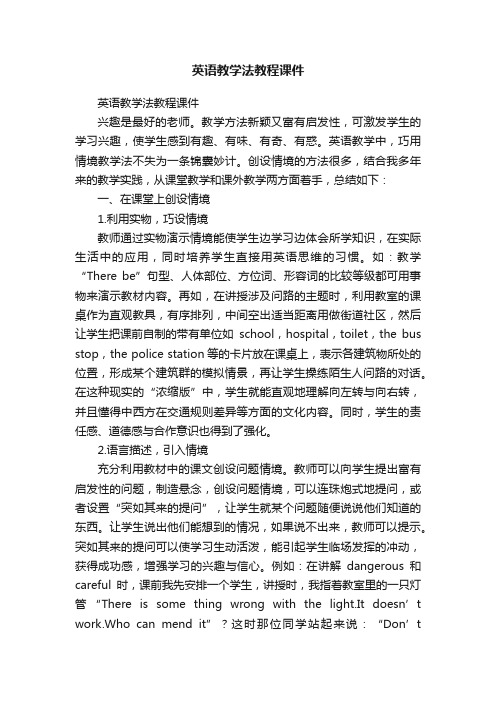
英语教学法教程课件英语教学法教程课件兴趣是最好的老师。
教学方法新颖又富有启发性,可激发学生的学习兴趣,使学生感到有趣、有味、有奇、有惑。
英语教学中,巧用情境教学法不失为一条锦囊妙计。
创设情境的方法很多,结合我多年来的教学实践,从课堂教学和课外教学两方面着手,总结如下:一、在课堂上创设情境1.利用实物,巧设情境教师通过实物演示情境能使学生边学习边体会所学知识,在实际生活中的应用,同时培养学生直接用英语思维的习惯。
如:教学“There be”句型、人体部位、方位词、形容词的比较等级都可用事物来演示教材内容。
再如,在讲授涉及问路的主题时,利用教室的课桌作为直观教具,有序排列,中间空出适当距离用做街道社区,然后让学生把课前自制的带有单位如school,hospital,toilet,the bus stop,the police station等的卡片放在课桌上,表示各建筑物所处的位置,形成某个建筑群的模拟情景,再让学生操练陌生人问路的对话。
在这种现实的“浓缩版”中,学生就能直观地理解向左转与向右转,并且懂得中西方在交通规则差异等方面的文化内容。
同时,学生的责任感、道德感与合作意识也得到了强化。
2.语言描述,引入情境充分利用教材中的课文创设问题情境。
教师可以向学生提出富有启发性的问题,制造悬念,创设问题情境,可以连珠炮式地提问,或者设置“突如其来的提问”,让学生就某个问题随便说说他们知道的东西。
让学生说出他们能想到的情况,如果说不出来,教师可以提示。
突如其来的提问可以使学习生动活泼,能引起学生临场发挥的冲动,获得成功感,增强学习的兴趣与信心。
例如:在讲解dangerous和careful时,课前我先安排一个学生,讲授时,我指着教室里的一只灯管“There is some thing wrong with the light.It doesn’t work.Who can mend it”?这时那位同学站起来说:“Don’tworry.I can mend it.”说完,他就走过来并假装去触摸灯管,这时我显出一种极为紧张的表情并大声说:“Becareful!It’s dangerous!”我一边在黑板上用红色粉笔画出“触电”标志符号,一边大声重复:“B ecareful!It’s dangerous!”这时再问同学们它们的含义,学生便能异口同声地说出来。
英语教学法教程lectu幻灯片PPT
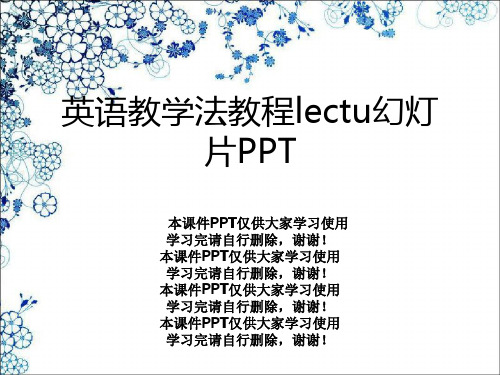
Constructivist theory
❖ 4. How can one become a good language teacher?
❖ 5. Try to explain “reflective model〞 in your own words.
Assignment:
语法翻译教学法(grammar-translation method〕 听说教学法 (Audio-lingual method) 交际教学法 (communicative language teaching
❖ As a teaching strategy, scaffolding is defined as the process by which an expert provides temporary support to learners to "help bridge the gap between what the learner knows and can do and what he or she needs to accomplish in order to succeed at a particular learning task.“
❖ It suggested language is a form of behavior and language learning involves the same procedure as an animal is trained to respond to stimuli.
英语教学法教程PPTunit11
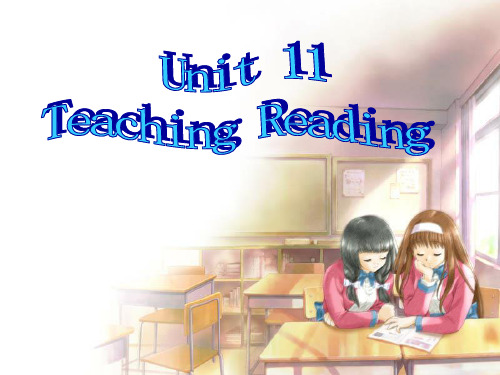
do not need to use it while they are reading.(Oakhill and Garnham,1988) 4. Good readers know the language. They can decode with occasional exceptions, both the lexical and syntactic structures they encounter in texts, and they do so for the most part, not by guessing from context or prior knowledge by the word, but by a kind of automatic identification that requires no conscious effort.(Eskey D 1988)
contents
Research findings about good readers Factors affecting reading Strategies in reading comprehension Principles in teaching reading Approaches of teaching reading Three levels of reading Objectives of teaching reading
4
Guidelines for reading instruction Contents of teaching instruction Classroom activities Reading stages
王蔷英语教学法教程第二版Unit11
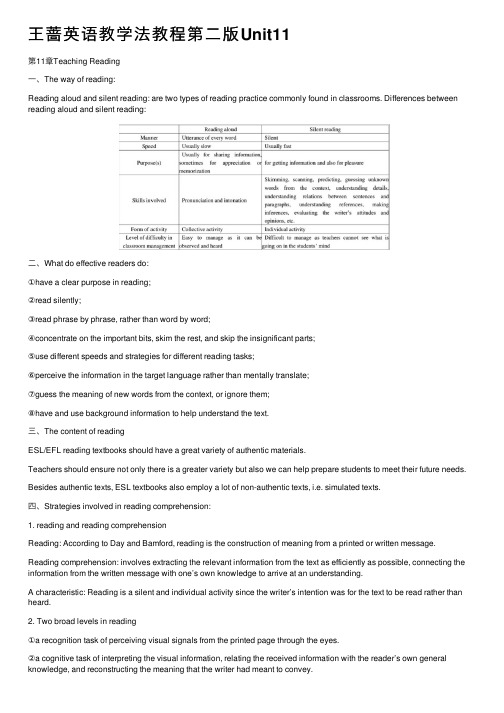
王蔷英语教学法教程第⼆版Unit11第11章Teaching Reading⼀、The way of reading:Reading aloud and silent reading: are two types of reading practice commonly found in classrooms. Differences between reading aloud and silent reading:⼆、What do effective readers do:①have a clear purpose in reading;②read silently;③read phrase by phrase, rather than word by word;④concentrate on the important bits, skim the rest, and skip the insignificant parts;⑤use different speeds and strategies for different reading tasks;⑥perceive the information in the target language rather than mentally translate;⑦guess the meaning of new words from the context, or ignore them;⑧have and use background information to help understand the text.三、The content of readingESL/EFL reading textbooks should have a great variety of authentic materials.Teachers should ensure not only there is a greater variety but also we can help prepare students to meet their future needs. Besides authentic texts, ESL textbooks also employ a lot of non-authentic texts, i.e. simulated texts.四、Strategies involved in reading comprehension:1. reading and reading comprehensionReading: According to Day and Bamford, reading is the construction of meaning from a printed or written message. Reading comprehension: involves extracting the relevant information from the text as efficiently as possible, connecting the information from the written message with one’s own knowledge to arrive at an understanding.A characteristic: Reading is a silent and individual activity since the writer’s intention was for the text to be read rather than heard.2. Two broad levels in reading①a recognition task of perceiving visual signals from the printed page through the eyes.②a cognitive task of interpreting the visual information, relating the received information with the reader’s own general knowledge, and reconstructing the meaning that the writer had meant to convey.3. The skills involved in reading: reading strategies五、The role of vocabulary in readingA large majority of students believe that vocabulary is the main obstacle in learning to read and this has already been pointed out by Grabe.The lack of such vocabulary may be the greatest single impediment of fluent reading.Fluent reading depends on an adequate sight vocabulary, a general knowledge about the target language, some knowledge about the topic, wide knowledge about the world and enough knowledge about text types. According to Day and Bamford, efficient reading begins with a lightening-like automatic recognition of words. This initial process of accurate, rapid and automatic recognition of vocabulary frees one’s mind to use other resources.Less the 3% of new words in a reading text will enable smooth, meaningful and enjoyable reading. Therefore, helping students to develop the ability of automatic word recognition is the basis for developing their reading skills.Sight vocabulary: words that one is able to immediately recognize with both sounds and meanings without special effort from the brainThe best and easiest way to develop sight vocabulary is to read extensively.Through intensive and extensive reading;Keeping a vocabulary notebook;Using a dictionary;However, the materials chosen must be at the right level and a degree of monitoring should be available to keep the motivation high so that students can feel a sense of achievement by sharing their reading experiences with others.六、Principles and models for teaching reading1. Principles for teaching reading:1) The selected texts and attached tasks should be accessible to the students.2) Tasks should be clearly given in advance.3) Tasks should be designed to encourage selective and intelligent reading for the main meaning rather than test thestudents’ understanding of trivial details.4) Tasks should help develop student’s reading skills rather than test reading comprehension.5) Develop student’s reading strategies and reading ability in general.6) Provide enough guidance at the beginning and help them become independent reader eventually.2. Models of teaching reading(1)Bottom-up modelThe way one teaches reading always reflects the way one understands reading and the reading process. Some teachers teach reading by introducing new vocabulary and new structures first and then going over the text sentence by sentence. This is followed by some questions and answers and reading aloud practice.Reading comprehension is based on the understanding and mastery of all the new words, new phrases, and new structures as well as a lot of reading aloud practice.In reading, information is transmitted along a linear process: letters—words—phrases—clauses—sentences—paragraphs—whole discourse.(2)Top-down model -- Schema theoryBottom-up model believes that one’s background knowledge plays a more important role than new words and new structures in reading comprehension.Teaching process: the teacher should teach the background knowledge first so that students equipped with such knowledge will be able to guess meaning from the printed page.Reading process: a psycholinguistic guessing game(Goodman, 1970).(3)Interactive modelThe current theory views reading as an interactive process.Reading comprehension is based on the interactive process between visual information obtained from the reading materials and the readers’ prior knowledge.Reading process: brain receives visual information and at the same time, interprets or reconstructs the meaning the writer had in mind when he wrote the text. This process does not only involve the printed page but also the reader’s knowledge of the language in general, of the world, and of the text types.七、Reading activitiesThe three stages are pre-reading, while-reading, and post-reading.1. Pre-reading activities(1) Definition of pre-reading activitiesPre-reading activities refer to tasks/activities that students do before they read the text in detail.(2) Purpose:To stimulate students’ interests, to facilitate while-reading activities. By:①pooling existing knowledge about the topic;②predicting the contents of the text;③skimming or scanning the text or parts of the text for certain purposes;④learning key words and structures.To sum up, the purpose is to prepare the students linguistically, thematically and affectively for the tasks in while-reading activities.(3) Pre-reading activities in details:1) Predicting—confirm or reject prediction in readingPredicting will get the mind close to the theme of the text to be read, making reading more intriguing and purposeful and resulting in better comprehension compared with the situation where the learner starts reading with a blank mind. Predictions can be done in many different ways①Predicting based on the title;②Predicting based on vocabulary;③Predicting based on the T/F questions.2) Setting the scene1) Aim: get the students familiarized with the cultural and social background knowledge relevant to the reading text.2) Ways of setting the scene:①Discussing culture-bound aspects of the text;②Relating what students know to what they want to know, and then ask the students to read the text to see if they can find what they want to know;③Using visual aids to set the scene.3) SkimmingIt means to read quickly to get the gist.4) ScanningReading for specific information, and should ignore the irrelevant parts when reading.2. While-reading activitiesThere are two ways of exploiting texts:1) Focusing on the results of reading:Multiple-choice questions; T/F; open questions, paraphrasing, translation.2) Focusing on the process of understanding:①Information transfer activities:When information in text form is transferred to another form , it can be more effectively processed and retained. Information transfer activities: The way to transfer information from one form to another is called a transition device.Purposes of transition deviceWhen using transition devices, we need to ensure that it is an appropriate form to encapsulate the main information contained in the text. We need to bear in mind the purposes of transition devices.①Focus attention on the main meaning of the text②Be able to simplify sophisticated input so that it becomes the basis for output;③Allow students to perform tasks while they are reading;④Highlight the main structural organization of a text/part of a text, and show how the structure relates to meaning;⑤Involve all the students in clearly defined reading tasks;⑥Precede one step at a time and students should do easier tasks before doing more complicated ones;⑦When a TD is completed, use it as a basis for further oral or written language practice.②Reading comprehension questionsNuttall’s classification of reading questions①Questions of literal comprehension;②Questions involving reorganization or reinterpretation;③Questions for inferences;④Questions for evaluation or appreciation;⑤Questions for personal response.③Understanding referencesAll natural language, spoken or written, uses referential words such as pronouns to refer to people or things already mentioned previously in the context. Understanding what these words refer to is crucial forcomprehension.④Making inferencesIt requires the reader to use background knowledge in order to infer the implied meaning of the author. Making inferences is actually the process of relating the given information to what we have known about the world. 3. Post-reading Activities(1) Objectives①To check the fulfillment of reading tasks;②To evaluate the application of reading strategies;③To apply what has been learned;④To integrate reading with other skills.(2) RequirementsPost-reading tasks should provide the students with opportunities to relate what they have read to what they already know or what they feel.Post-reading tasks should enable students to produce language based on what they learned.(3) Types of post-reading activitiesRole play, Gap-filling, Discussion, Retelling and Writing.。
- 1、下载文档前请自行甄别文档内容的完整性,平台不提供额外的编辑、内容补充、找答案等附加服务。
- 2、"仅部分预览"的文档,不可在线预览部分如存在完整性等问题,可反馈申请退款(可完整预览的文档不适用该条件!)。
- 3、如文档侵犯您的权益,请联系客服反馈,我们会尽快为您处理(人工客服工作时间:9:00-18:30)。
do not need to use it while they are reading.(Oakhill and Garnham,1988) 4. Good readers know the language. They can decode with occasional exceptions, both the lexical and syntactic structures they encounter in texts, and they do so for the most part, not by guessing from context or prior knowledge by the word, but by a kind of automatic identification that requires no conscious effort.(Eskey D 1988)
contents
Research findings about good readers Factors affecting reading Strategies in reading comprehension Principles in teaching reading Approaches of teaching reading Three levels of reading Objectives of teaching reading
2.Reading is a creative art, reading is interaction, reading id interpretation, reading is a social art, and reading is responding.( Eric)
3.Reading is an interactive process, involvtypes of language knowledge, any of which may interact with any other to contribute to text comprehension. (Carrell et al 1988)
4
Guidelines for reading instruction Contents of teaching instruction Classroom activities Reading stages
5
Research findings about fluent/good readers
1.The difference between good readers and poor readers may lie not in their ability to guess, but in their decoding skills(Paran,1996) 2. Good readers use context less than poor readers do. They
6
5. Word recognition is automatic in good readers.( Mitchell,1982)
6. Poor readers most make use of contextual redundancy to facilitate recognition.
7. A fluent reader may possess the skill of rapid, automatic word recognition, but may resort to strategies such as phonological encoding when faced with an unfamiliar word. Fluent readers typically ignore rather than guess unknown lexis ( Tlmlinson& Ellis, 1987)
Aims of the Unit
To understand the meaning of reading To understand what are the components for the good reader To know the factors affecting the reading process To know three models for reading and three levels of reading To get to know the principles of reading and teaching reading stages and activities
4. Reading is an active process of comprehending and the students need to be taught strategies to read more efficiently. (Clark and Silberstein 1977)
3
2
What is reading?
1.Reading is a psycholinguistic guessing game, a process in which readers sample the text, make hypotheses about what is coming next, sample the text again in order to test their hypotheses, confirm(or disconfirm) them, make new hypotheses, and so forth.(Goodman,1967)
